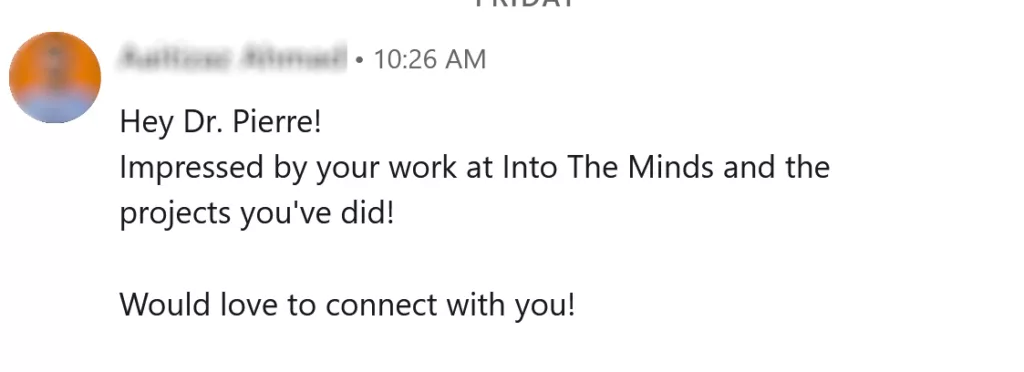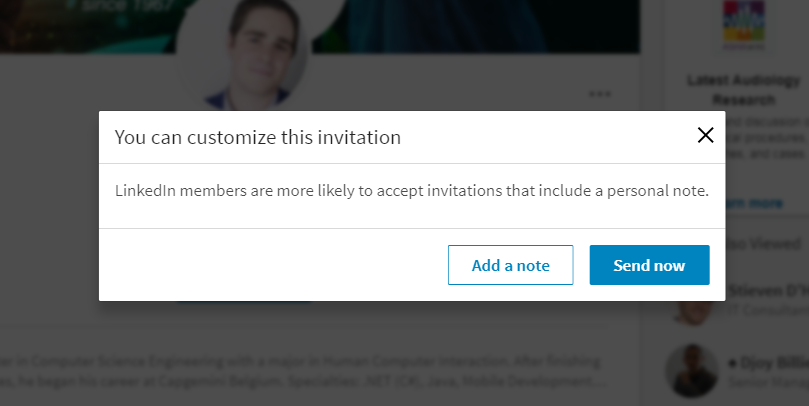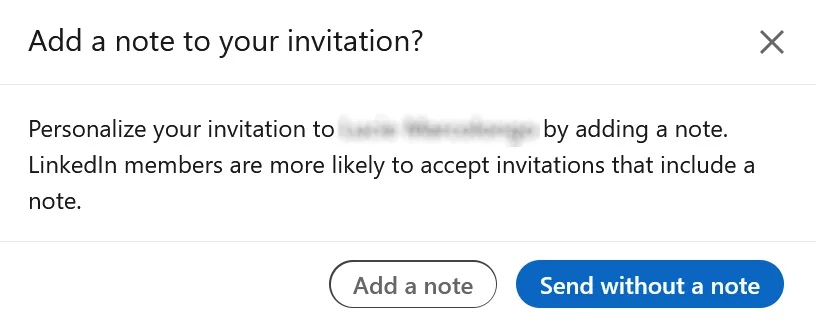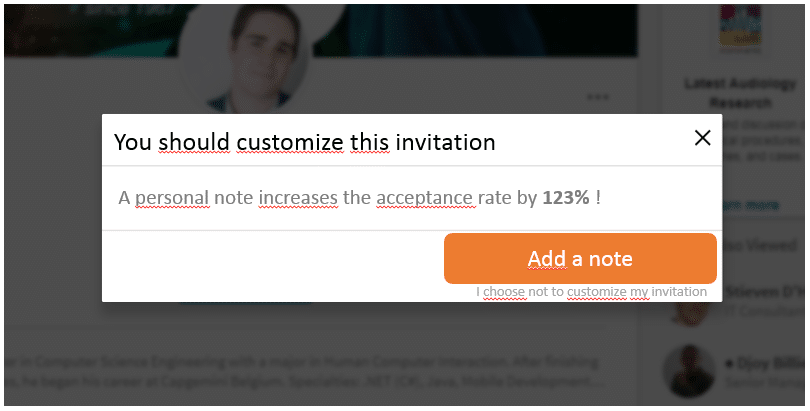87% of LinkedIn invitations do not include a personalized message; the remaining 13% are only plain text. LinkedIn’s strength lies in its network, so you must know who you’re letting in. Yet the solution is simple. All we need to do is use a nudge to encourage users to personalize their connection requests. In this article, I share some statistics on invitations received on LinkedIn and propose a contemporary design to make them more personalized.
Contact IntoTheMinds marketing agency
87% of LinkedIn invitations are not personalized
Over 12 months, I kept track of all the LinkedIn invitations I received: 87% were not accompanied by any explanation. In other words, there needed to be a message to explain why someone would like to add you to their network.
Of the remaining 13%, the vast majority included a banal message and one generated by generative AI (see below). This kind of message doesn’t make you want to know more about the person.

The person sending the invitation rarely tried to write a personalized message.
The benefits of a personalized invitation on LinkedIn
The first benefit is a higher acceptance rate for your connection request. This hypothesis is quite logical, even if a statistic suggests otherwise.
What is certain, however, is that:
- 20% of users NEVER accept connection requests from strangers
- 68% accept some of them (and in this case, we can assume that personalization plays a role)
- 12% accept all incoming requests
In real life, no one comes to your home without asking permission, being invited, and saying hello.
Bruno Fridlansky, LinkedIn expert
If you want to grow your network to increase the “reach” of your messages (see our research on the subject here), your invitations must be accepted. Remember, too, that the number of invitations you can send is now limited to 100, and you may be penalized if your connection requests are too often ignored or rejected.
The second benefit is building a network of people you know and with whom you can develop real relationships. A network is useless if you can’t activate it. So, network size is not the only important KPI. The network quality counts, but it’s much more work to make this notion of quality tangible.
Invitations on LinkedIn: a frustrating subject
For many users, these non-personalized invitations are a source of frustration. Yet LinkedIn needs to do something to improve the situation. The site has stayed the same for 10 years.
In 2017 (see below), a message timidly encouraged users to personalize it.
2023, the message still needs to be changed (see below). Above all, the position of the 2 buttons (“add a note” and “send without a note”) hasn’t changed, nor has their color. It’s still too easy for the user not to make an effort.
Yet, the solution exists. It’s in the design. It’s called nudge.
Several things could be improved in the current design of LinkedIn’s invitation interface. Users are encouraged to send an invitation without including a personalized note. This is a bad practice that LinkedIn’s design encourages rather than combats. The “send without a note” button is located at the far right of the window, the button the user’s mouse first clicks on. Secondly, this button is much more visible than the “Add a note” personal message button.
A nudge to improve LinkedIn user satisfaction
Encouraging users to provide this explanation would only require a few lines of code. The solution would take the form of a nudge rather than a ban. It wouldn’t be effective to force users to provide a message. They need to see for themselves the benefits of a personalized invitation.
The interface should be designed to encourage users to personalize their invitations, thus giving the recipient an extra incentive to connect. I therefore propose to redesign the interface as follows:
- Make the “Add a note” button the default option instead of “Send now”: the “Add a note” button could simply become more prominent
- Use a number (here “123%”) to give the user a measure of the change he can expect thanks to the effort made
- Make the “send now” button less visible
- Rename the “send now” action to make it more guilt-inducing (“I choose not to personalize my invitation”).
We could imagine that clicking “I choose not to personalize my invitation” would trigger a popup to confirm this action: “Are you sure you don’t want to personalize your invitation? If more is needed, the next step would be to allow users to control the type of invitation they wish to receive (personalized only or both).
Conclusion
LinkedIn has stayed its position on personalized connection requests for over 10 years. It’s still easier to send non-personalized invitations.
I plead for changes to be made to the login request. An innovative design would undoubtedly make users more aware of the benefits of a personalized invitation and improve the quality of their network and user satisfaction.
In the meantime, those who try to personalize their messages (without the help of ChatGPT) will undoubtedly receive a better welcome and, therefore, have an advantage.
Posted in Marketing.



